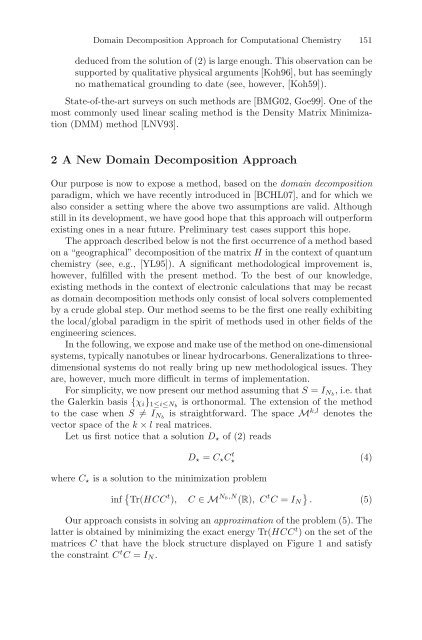Partial Differential Equations - Modelling and ... - ResearchGate
Partial Differential Equations - Modelling and ... - ResearchGate
Partial Differential Equations - Modelling and ... - ResearchGate
Create successful ePaper yourself
Turn your PDF publications into a flip-book with our unique Google optimized e-Paper software.
Domain Decomposition Approach for Computational Chemistry 151<br />
deduced from the solution of (2) is large enough. This observation can be<br />
supported by qualitative physical arguments [Koh96], but has seemingly<br />
no mathematical grounding to date (see, however, [Koh59]).<br />
State-of-the-art surveys on such methods are [BMG02, Goe99]. One of the<br />
most commonly used linear scaling method is the Density Matrix Minimization<br />
(DMM) method [LNV93].<br />
2 A New Domain Decomposition Approach<br />
Our purpose is now to expose a method, based on the domain decomposition<br />
paradigm, which we have recently introduced in [BCHL07], <strong>and</strong> for which we<br />
also consider a setting where the above two assumptions are valid. Although<br />
still in its development, we have good hope that this approach will outperform<br />
existing ones in a near future. Preliminary test cases support this hope.<br />
The approach described below is not the first occurrence of a method based<br />
on a “geographical” decomposition of the matrix H in the context of quantum<br />
chemistry (see, e.g., [YL95]). A significant methodological improvement is,<br />
however, fulfilled with the present method. To the best of our knowledge,<br />
existing methods in the context of electronic calculations that may be recast<br />
as domain decomposition methods only consist of local solvers complemented<br />
by a crude global step. Our method seems to be the first one really exhibiting<br />
the local/global paradigm in the spirit of methods used in other fields of the<br />
engineering sciences.<br />
In the following, we expose <strong>and</strong> make use of the method on one-dimensional<br />
systems, typically nanotubes or linear hydrocarbons. Generalizations to threedimensional<br />
systems do not really bring up new methodological issues. They<br />
are, however, much more difficult in terms of implementation.<br />
For simplicity, we now present our method assuming that S = I Nb , i.e. that<br />
the Galerkin basis {χ i } 1≤i≤Nb is orthonormal. The extension of the method<br />
to the case when S ≠ I Nb is straightforward. The space M k,l denotes the<br />
vector space of the k × l real matrices.<br />
Let us first notice that a solution D ⋆ of (2) reads<br />
where C ⋆ is a solution to the minimization problem<br />
D ⋆ = C ⋆ C t ⋆ (4)<br />
inf { Tr(HCC t ), C ∈M N b,N (R), C t C = I N<br />
}<br />
. (5)<br />
Our approach consists in solving an approximation of the problem (5). The<br />
latter is obtained by minimizing the exact energy Tr(HCC t ) on the set of the<br />
matrices C that have the block structure displayed on Figure 1 <strong>and</strong> satisfy<br />
the constraint C t C = I N .
















